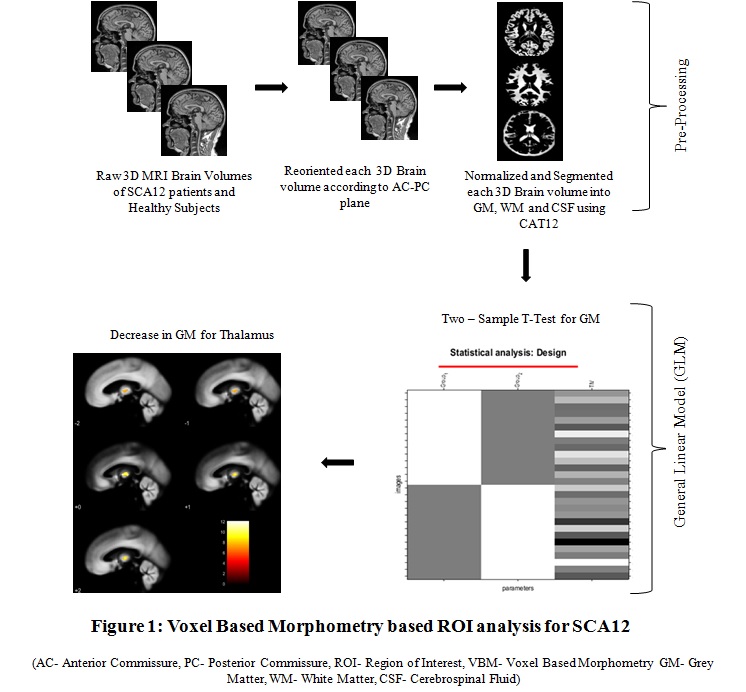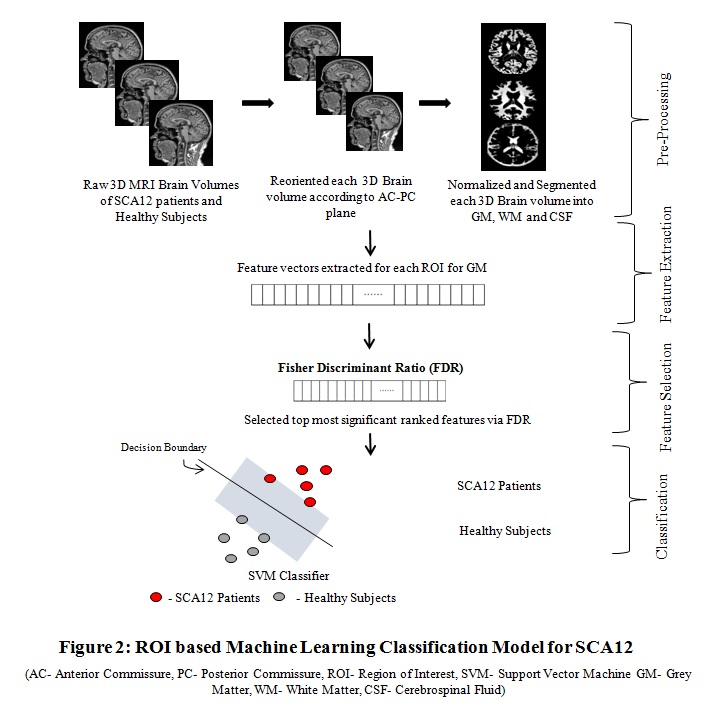Category: Ataxia
Objective: To find specific Region of Interests (ROI) with atrophy in Spinocerebellar ataxia type 12 (SCA12) patients using a machine learning classification model with respect to Healthy Controls (HC).
Background: Spinocerebellar Ataxia (SCA) is a progressive neurological disorder. Though the prevalence of SCA12 is less around the world, quite a few cases have been found in North India with an incidence rate of 12% among the reported Cerebellar Ataxia patients [1]. SCA12 is characterized by prominent action tremor in the upper limbs, along with gait ataxia, slurring of speech, hyperreflexia, etc. [2]. In literature, ROIs reported were based on the gross analysis.
Method: Whole-brain isotropic T1 MRI data was acquired using a 32 channel head coil in a 3T MR scanner (Ingenia 3T). Fourteen genetically confirmed SCA12 (9M/5F, mean age: 42.85 ± 6.57 years) patients and fourteen (age and gender-matched) healthy subjects as controls (9M/5F, mean age: 42.42 ± 6.54 years) were recruited. Normalized segmented images were obtained using the CAT12 toolbox. Two-sample t-test was used for intergroup analysis using voxel-based morphology (VBM) for voxel-based comparison using Total Intracranial Volume (TIV) as a covariate. Features obtained from each ROI (ROIs found in literature along with symptom-specific ROIs) were ranked using Fisher Discriminant Ratio (FDR) [3] and fed into Support Vector Machine [4] to classify the two classes (SCA12 and HC) using leave one out cross-validation (LooCV) scheme.
Results: The machine learning based ROI analysis for grey matter (GM)revealed a classification accuracy of 96.43% for Somatosensory Cortex (BA3) and Thalamus, 92.85% for Primary motor cortex (BA4) and Wernicke’s Area (BA22); 89.28% for Premotor cortex (BA6) and Superior Temporal Gyrus (BA41,42) and 82.41% for Broca’s Area (BA44,45). The VBM based ROI analysis for GM revealed significant volumetric atrophy only in Thalamus area for p<0.05 (FDR corrected).
Conclusion: The machine learning based ROI analysis revealed atrophy in motor, Wernicke’s and Broca’s areas in SCA12 patients (with respect to HC), which are associated with the clinical symptoms. The ROI based machine learning classification modelmay aid in better prediction/diagnosis of SCA12 patients.
References: 1. Kumari R, Kumar D, Brahmachari SK, Srivastava AK, FaruqM, Mukerji M. Paradigm for disease deconvolution in rare neurodegenerative disorders in Indian population: Insights from studies in cerebellar ataxias. J Genet 2018;97:589-609. 2. Srivastava AK, Choudhry S, Gopinath MS, Roy S, TripathiM, Brahmachari SK, et al. Molecular and clinical correlation in five Indian families with spinocerebellar ataxia 12. Ann Neurol2001;50:796-800. 3. R. A. Fisher, “The use of multiple measures in taxonomic problems”, Ann. Eugenics, vol. 7, pp. 179-188, 1936. 4. C. Cortes and V. Vapnik, “Support-vector networks,” Machine learning, vol. 20, no. 3, pp. 273–297, 1995.
To cite this abstract in AMA style:
S. Agrawal, M. Narang, P. Pankaj, A. Srivastava, S. Kumaran, R. Agrawal. ROI based Machine Learning Classification Model for Spinocerebellar Ataxia type 12 [abstract]. Mov Disord. 2020; 35 (suppl 1). https://www.mdsabstracts.org/abstract/roi-based-machine-learning-classification-model-for-spinocerebellar-ataxia-type-12/. Accessed December 23, 2025.« Back to MDS Virtual Congress 2020
MDS Abstracts - https://www.mdsabstracts.org/abstract/roi-based-machine-learning-classification-model-for-spinocerebellar-ataxia-type-12/


